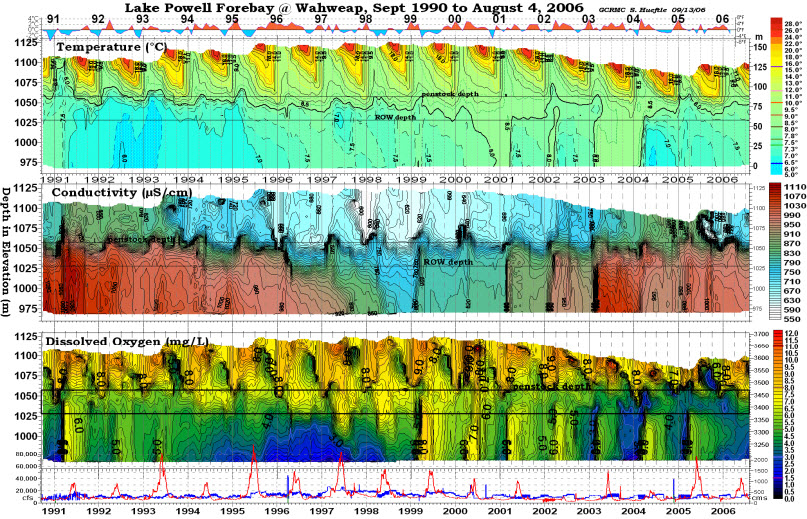Difference between revisions of "WATER QUALITY"
Cellsworth (Talk | contribs) |
Cellsworth (Talk | contribs) |
||
| Line 114: | Line 114: | ||
|- | |- | ||
| − | ! <h2 style="margin:0; background:#cedff2; font-size:120%; font-weight:bold; border:1px solid #a3b0bf; text-align:left; color:#000; padding:0.2em 0.4em;"> | + | ! <h2 style="margin:0; background:#cedff2; font-size:120%; font-weight:bold; border:1px solid #a3b0bf; text-align:left; color:#000; padding:0.2em 0.4em;"> Modifying releases at Glen Canyon Dam to improve water quality in the Lees Ferry reach </h2> |
|- | |- | ||
|style="color:#000;"| | |style="color:#000;"| | ||
| + | ==Rough operation of the turbines== | ||
| + | Increases the oxygenation of water going through the power plant | ||
| + | Is damaging to the turbines | ||
| + | *[https://www.usbr.gov/newsroom/newsrelease/detail.cfm?RecordID=8041 Reclamation to continue experimental operations at Glen Canyon Dam to increase dissolved oxygen (2005)] | ||
| + | |||
| + | ==Oxygenation of the tailwater using the bypass tubes== | ||
| + | According to [https://www.usbr.gov/lc/region/pao/pdfiles/crbproj.pdf Sec 602a of the Colorado River Basin Project Act (1968)], the bypass tubes at Glen Canyon Dam can only be used to avoid anticipated spills from Lake Powell. The Colorado River Basin States have agreed to allow bypass at Glen Canyon Dam for HFEs on the condition that it be done as part of an experiment and not a management action or operational decision. Costs associated with any release that bypasses the powerplant for reasons other than to avoid a spill or for experimentation relating to HFEs would have to be borne by the GCDAMP (see DOI determination for costs of the 2004 BHBF). | ||
| + | |||
| + | ==Adding power generation to the bypass tubes== | ||
| + | Allows for drawing water from deeper in Lake Powell: colder and more oxygenated water | ||
*[[Media:Generation at Outlet Glen Canyon Dam Plan of Study CRSP Power Peaking Capacity (March 1981).pdf|Generation at Outlet Glen Canyon Dam Plan of Study CRSP Power Peaking Capacity (March 1981)]] | *[[Media:Generation at Outlet Glen Canyon Dam Plan of Study CRSP Power Peaking Capacity (March 1981).pdf|Generation at Outlet Glen Canyon Dam Plan of Study CRSP Power Peaking Capacity (March 1981)]] | ||
Revision as of 16:58, 2 October 2017
|
|
Desired Future Condition for Water QualityWater quality with regards to dissolved oxygen, nutrient concentrations and cycling, turbidity, temperature, etc., is sufficient to support natural ecosystem functions, visitor safety and visitor experience to the extent feasible and consistent with the life history requirements of focal aquatic species. |
| --- |
--- |
--- |
|---|
|
|
